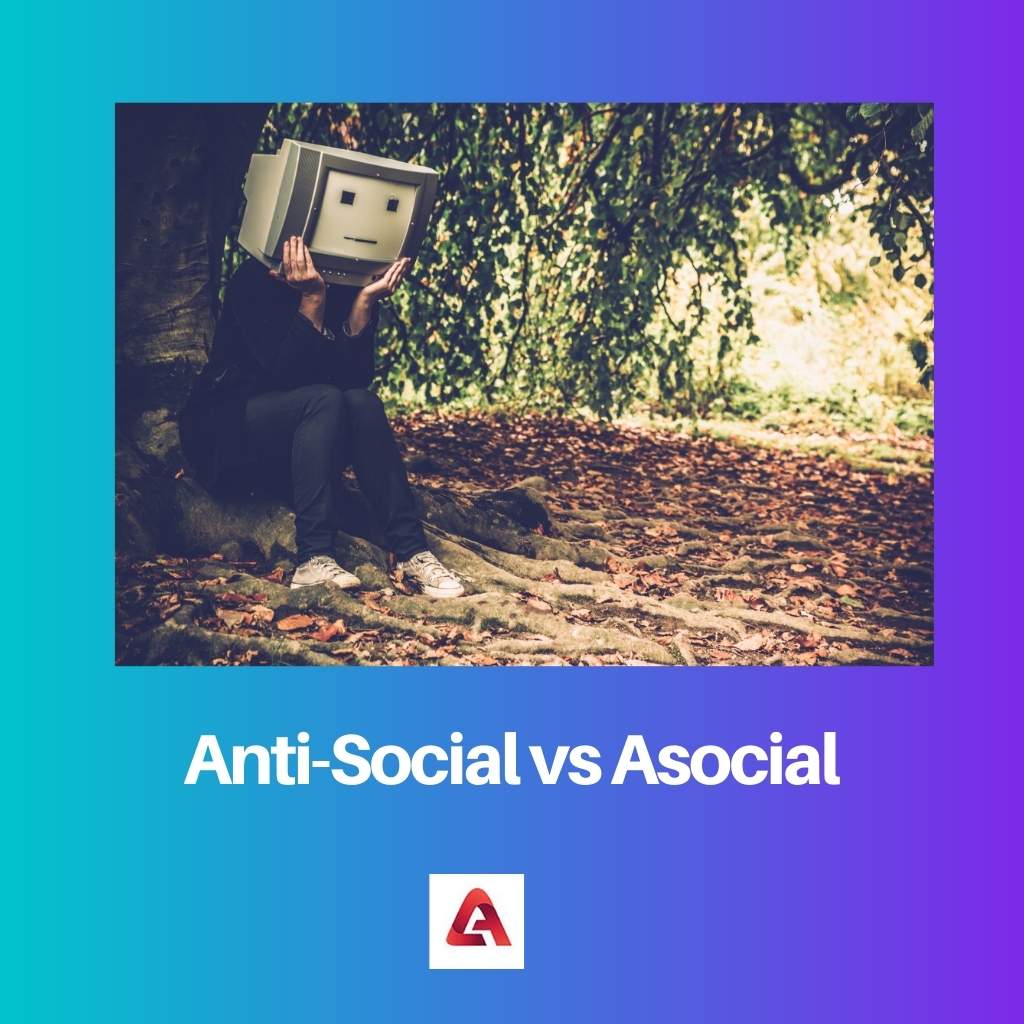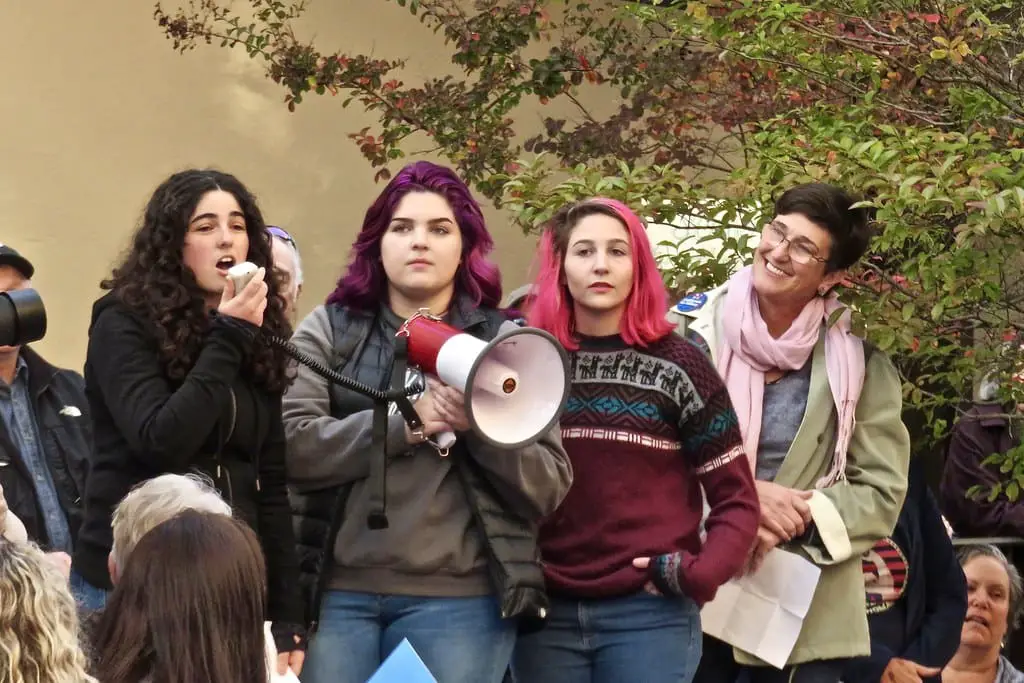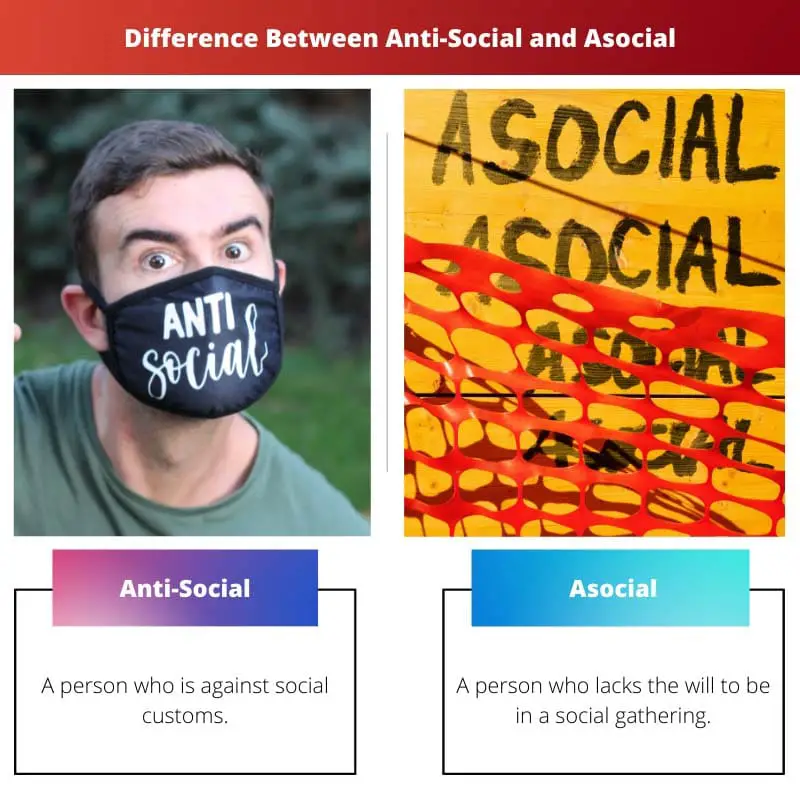Anti-social and Asocial look like two words with the same meaning, however, these two words have two different meanings. Both these words show the main meaning is the lack of interaction with society.
An asocial person is the one who keeps to himself/herself, while the anti-social is one who doesn’t like other people.
Key Takeaways
- Anti-social behavior is characterized by deliberate acts that harm others or violate social norms, while asocial behavior is a lack of interest in social interactions.
- Anti-social individuals may be aggressive or hostile, while asocial individuals are passive and withdrawn.
- Anti-social behavior can lead to legal consequences, whereas asocial behavior is not considered illegal or harmful.
Anti-Social vs Asocial
Anti-social means against morally appropriate behaviour, while asocial means avoidance of social life. Antisocial behaviour is caused by repression of emotions, bad experiences and negative thinking, while Asocial behaviour simply develops as one’s attitude towards life due to introverted nature.

Anti-social people are people who are against social interactions. These people can be harmful or annoying to other people. The behaviours of these people are extremely sharp, and they can be manipulative as well.
Anti-social people show disregard for social gatherings and the customs of society.
Asocial people are those who don’t like to be gathered around people. They prefer being alone. These people don’t like being a part of social activities. Asocial people are like introverts who like to be on their own most of the time.
They only enjoy the company of their close ones. And they don’t have many people close to them, just a few.
Comparison Table
| Parameters of Comparison | Anti-social | Asocial |
|---|---|---|
| Definition | A person who is against social customs. | A person who lacks the will to be in a social gathering. |
| Behavior | Anti-social people can get aggressive and frustrated very easily. | They are like introverts; just don’t want to be socially active. Shows no sign of being violent. |
| Impact on society | These people can be harmful to other people because of their behavior. | These people are not harmful at all. They are the silent type of people. |
| Causes | The cause can be a negative environment around them for their childhood or a mental disorder. | It’s just a personality trait. |
| Remedy | Talk Therapy, Cognitive-behavioral therapy. | Social Skills Training, Meta-cognitive interpersonal Therapy |
What is Anti-social?
Anti-social behaviour within people can be the result of violence, abuse, negativity, and no proper guidance. Anti-social people lack basic human kindness and empathy.
Anti-social people don’t consider the well-being of other people. They don’t approve of the way society works. Anti-social people don’t lack the will to interact, and they don’t entirely approve of social norms. They need things to be done the way they want.
These people can be dangerous to other people. They are impulsive and aggressive people who can get angry at the smallest of arguments. They can violate the basic rights of other people and have persistence in their behaviour.
They are negligent in their cooperative skills. And are frustrated most of the time. Mostly these people have a history of violence.
Mostly, people with antisocial behaviour have antisocial personality disorder. They can be charming people, but their behaviour can change in a second of time.
They highly think of themselves to be right, and they don’t like to hear other people’s opinions or perceptions. Indeed, they have poor bonds. They don’t have much emotional attachment to people.
Cognitive-behavioural therapy, Behavioural parent training, Psychotherapy, or Talk therapy are some of the treatments to overcome Anti-social behaviour.

What is Asocial?
Asocial is a person who likes to stay in his/her own little world. A person who rather stay alone than go to a party. Asocial people don’t have violent or aggressive behavior. They just lack the will to be in a social gathering.
Asocial people like to get interacted with their close ones only. They form emotional bonds but they don’t like to interfere in other people’s life. They prefer their mental health and private life.
They are not party people. They like to go to the social gathering but in a limited way and for a limited amount of time. They mostly enjoy their time with themselves at home or at silent places they like.
Being asocial is not a negative trait, it’s just a personality trait. Indeed, it is seen as a desirable trait in religious ways of life in heritages like Hinduism, Jainism, Buddhism, etc.
Asocial people are not very explicit about their life. They don’t like to share things with everyone, they are the ones who keep things to themselves. They don’t like to be an active part of a gathering. They are the ones who listen. They cant get engaged in endless conversations.

Main Differences Between Anti-Social and Asocial
- Anti-social shows antagonism towards other people. They can be dangerous. Asocial people don’t show such behaviour. They are not harmful at all.
- Anti-social people disregard social norms. In contrast, Asocial people have no problem with social norms. They just like to stay in their own space.
- Being Anti-social can be because of a negative environment or bad influence. It can be a symptom of anti-social personality disorder. Being asocial is a personality trait, it’s not a negative trait.
- Anti-social people mostly cannot form emotional bonds, while asocial people have strong emotional bonds.
- Anti-social people show disregard for societal standards, and they don’t mind being in a gathering, while asocial people don’t show any regard towards anyone. They just mind their own business and like to interact less with people.

- https://psycnet.apa.org/record/1996-98939-004
- https://books.google.com/books?hl=en&lr=&id=F901DwAAQBAJ&oi=fnd&pg=PA337&dq=antisocial+and+asocial&ots=gQ1_8zJD9H&sig=_fMXQ8B67SoH1e4sflYzatx8UtQ

The comparison table provided is quite useful. It clearly outlines the distinctions between anti-social and asocial behaviors. Great work!
Indeed, Jacob. This article cuts through the ambiguity associated with these terms and provides clear explanations.
I appreciate the distinction drawn between anti-social and asocial behaviors. The comparison table is particularly helpful in conveying the differences effectively.
I agree, the level of precision in presenting the information is remarkable.
I concur, Shunt. A well-organized article like this offers valuable insight into sociological concepts.
The delineation of anti-social and asocial behaviors is presented meticulously in this article, enhancing clarity on this subject.
Absolutely, Jhill. The insights provided here significantly contribute to our knowledge of social behaviors.
I concur with both of you. The depth of information shared here is truly enlightening.
The extensive insights provided in this article greatly contribute to understanding anti-social and asocial behaviors in society.
Absolutely, Jlewis. It’s commendable how this article sheds light on these behavioral concepts.
The detailed comparison and lucid explanation of anti-social and asocial behaviors make this article an essential read for anyone seeking to understand these concepts.
I couldn’t agree more, Xtaylor. The article’s thoroughness is commendable.
This article meticulously details the variances between anti-social and asocial, making it easier to understand the complexities associated with social behaviors.
Absolutely, Alexander. The depth of information presented here is commendable.
I couldn’t agree more. The explanations are concise yet thorough, enhancing clarity on this subject.
An interesting article! I’ve always had doubts about the differences between ‘anti-social’ and ‘asocial’, and I’m glad to have found this information here.
I agree, George! This is a very informative article, and it clarifies a common misconception about these two terms.
This article provides a comprehensive understanding of anti-social and asocial behaviors, thereby enhancing our knowledge of social dynamics.
I concur with you, Summer. The detailed explanations are highly informative.
Indeed, Summer. The in-depth analysis offered here significantly contributes to a richer understanding of social concepts.
This article thoroughly elucidates the distinctions between anti-social and asocial behaviors, which is crucial in understanding social dynamics.
Indeed, Isabelle. The content here captures the essence of these behavioral concepts.
The comprehensive details provided here play a significant role in clarifying the differences between anti-social and asocial behaviors.
I completely agree, Davies. This article addresses a common misconception and offers a deeper understanding of the subject.